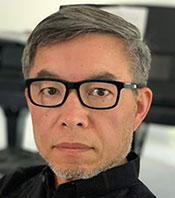
Chienchung Chang
Vice President, Engineering
Qualcomm Technologies Inc.
Boundless XR: Vision, Technology, and Challenges
Abstract:
Since the debut of 3G wireless data networks two decades ago, smartphone handily rides on the wave of ubiquitous wireless internet. The smartphone frenzy was witnessed by billions of users in the world. After the data speed was ramping up across generations of wireless networks, ultra high speed 5G networks were officially kicked off in the late of 2019. In the new era of 5G, we are leveraging the relevant, matured smartphone technologies to accelerate the recent advances of IoT, automotive and VR/AR (XR). In this talk, I’ll highlight the major progress and the challenges we are facing in XR, particularly on the technology forefront.
Biography
Chienchung Chang (M) received the B.S. from National Tsing-Hua University, Hsinchu, Taiwan, in 1982, M.S. and PhD degrees from University of California, San Diego, La Jolla, USA, in 1987 and 1991 respectively, all in electrical and computer engineering. Since 1991, Dr. Chang has been working with Qualcomm for almost 30 years. Currently, Dr. Chang is the Vice President of Engineering at Qualcomm Technologies where he serves as the department head of Multimedia R&D and Standards group with major focus in forward looking researches in the fields of speech, video, imaging, computer vision (CV), AI and XR (VR/AR) technologies. His R&D teams have been heavily engaged with standards in speech, video, imaging, computer vision as well.
Dr. Chang pioneered to introduce video, camera, and display technologies into Qualcomm Snapdragon® products. In 2005, he successfully led QCT’s first multimedia-centric chipset, MSM6550, from design to commercialization. MPEG-4/H.263 video codecs, 4MP CMOS image sensor and GPU were introduced into CDMA/WCDMA handsets for the first time. MSM6550 became the best-selling chipsets in company’s history then. The chipsets not only created watershed moment for wireless smartphone booming, but also laid a solid foundation to foster multimedia technology innovation within Snapdragon platforms up to today.
Dr. Chang was commissioned to start Multimedia R&D and Standards Group focusing on forward-looking multimedia research in speech, video, imaging, CV and XR. Under his leadership, Qualcomm won the ITU-T/MPEG H.265/HEVC, SVC, H.266/VVC, EVC video codec and 3GPP EVS speech codec standard competitions. These codec standards are expected to benefit smartphone, automotive, XR and internet of things (IoT) applications for years to come.
Dr. Chang helped Qualcomm publish 3D depth sensor technology based on structured lights (3DSL) and its own programmable hardware, RICA, in 2017. Together with 3D face authentication (3DFA) and relevant CV technologies, he proactively helped Qualcomm deliver the most competitive biometric solutions for Android handsets to counter iPhone FaceID. Lately, Dr. Chang led XR research, augmented by CV and machine learning research, in rolling out leading edge perception technologies such as 6DOF, 3D reconstruction, hand/object detection and tracking, digital human and split XR. These technologies enhance Qualcomm technology leadership and help it become the world largest VR/AR chipset vendor today.
Dr. Chang’s research interests include speech compression, speech recognition, imaging and video processing, computer vision, pattern recognition and machine learning. Dr. Chang holds 264 patents granted in the US and other countries including speech processing, compression and recognition, echo cancellation, voice user interface, video coding, display processing, and computer vision. He was recognized as Distinguished Alumni of College of EECS, National Tsing Hua University, Taiwan, April 2018.
